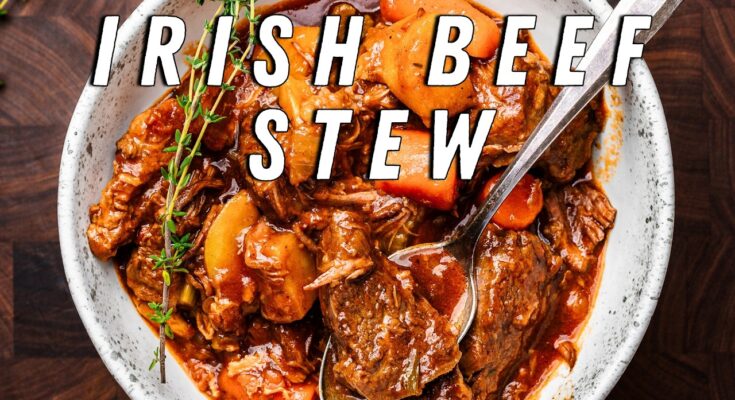Irish Stew Recipe: If you’re looking for a heartwarming dish that captures the essence of Ireland, Irish Stew is the perfect recipe to try. This dish, traditionally made with tender lamb or mutton, hearty vegetables, and simple seasonings, has been a staple in Irish households for centuries. It’s the ultimate comfort food that brings people together, whether for a cozy family dinner or a festive celebration.
But what makes Irish Stew so special? Its rich flavors, velvety broth, and melt-in-your-mouth ingredients combine to create a meal that’s both satisfying and nutritious.
This guide will walk you through making an authentic Irish Stew step by step, ensuring it’s as delightful as a warm Irish welcome.
Ingredients for Authentic Irish Stew
Traditional Ingredients
For a classic Irish Stew, you’ll need the following ingredients:
- Meat: Lamb shoulder or mutton, cut into chunks.
- Vegetables: Potatoes, carrots, and onions – staples of any Irish kitchen.
- Herbs and Seasonings: Fresh thyme, parsley, bay leaves, salt, and pepper.
- Liquid: Water or a light stock, sometimes with a splash of Guinness for depth.
Optional Additions
While the traditional recipe is simple, modern cooks often add leeks, celery, or parsnips for added flavor and texture.
Essential Kitchen Tools for Irish Stew
To create the perfect Irish Stew, you’ll need:
- A large pot or Dutch oven for slow cooking.
- Sharp knives for chopping.
- A sturdy ladle for serving.
- Serving bowls to complete the rustic presentation.
Step-by-Step Preparation of Irish Stew
Step 1: Preparing the Ingredients
Begin by washing and peeling the vegetables. Cut the potatoes into quarters, slice the carrots, and dice the onions. If you’re using additional vegetables like leeks or celery, chop them into bite-sized pieces. For the lamb or mutton, trim excess fat and cut it into even chunks for uniform cooking.
Step 2: Browning the Meat
Heat a bit of oil in your pot over medium heat. Add the meat chunks and brown them on all sides. This step enhances the flavor, creating a caramelized base that enriches the stew.
Step 3: Layering Ingredients in the Pot
Once the meat is browned, remove it from the pot and set it aside. Begin layering the ingredients, starting with the potatoes at the bottom (they help thicken the stew). Add the carrots, onions, and any additional vegetables, followed by the browned meat.
Step 4: Slow Cooking the Stew
Pour in water or stock until the ingredients are just covered. Add the herbs and seasonings, then bring the pot to a gentle boil. Reduce the heat to low, cover, and let it simmer for 2-3 hours. Stir occasionally, ensuring the ingredients cook evenly.
Tips for the Perfect Irish Stew
- Choose the Right Cut of Meat: Lamb shoulder is ideal for its marbled fat, which melts into the stew.
- Balance Flavors: Don’t be afraid to taste and adjust seasoning as the stew cooks.
- Ideal Texture: Aim for tender meat and soft vegetables without them turning mushy.
Serving Irish Stew
Serve your Irish Stew hot, garnished with fresh parsley. Pair it with crusty bread, Irish soda bread, or mashed potatoes for a complete meal. It’s perfect for sharing with family or entertaining guests.
Variations of Irish Stew
While traditional Irish Stew is delicious on its own, there are several variations to suit different preferences:
Beef Irish Stew
Substitute lamb with chunks of beef, such as chuck or stew meat. The cooking process remains the same, but the flavor shifts to a richer, beefier taste.
Vegetarian Irish Stew
For a meat-free option, skip the lamb and load up on hearty vegetables like parsnips, turnips, and mushrooms. Add a protein source like lentils or beans for added substance.
Modern Twists on Traditional Recipes
Experiment with wine, Guinness, or even a splash of balsamic vinegar for a depth of flavor. Some recipes incorporate pearl barley for a thicker, heartier stew.
Common Mistakes to Avoid
Overcooking the Vegetables
Vegetables should be tender but not falling apart. Add quicker-cooking vegetables like leeks or celery later in the cooking process.
Using the Wrong Type of Potatoes
Waxy potatoes can hold their shape better, while floury varieties help thicken the stew. Choose based on your desired texture.
Skipping Seasoning Layers
Seasoning as you go ensures the flavors are well-distributed. A sprinkle of salt after adding each layer of ingredients can make a big difference.
Storing and Reheating Irish Stew
Irish Stew stores well, making it perfect for meal prep or leftovers.
Proper Storage Techniques
Let the stew cool to room temperature before transferring it to an airtight container. Refrigerate for up to 3-4 days.
Reheating Without Losing Flavor
Reheat on the stovetop over low heat, stirring occasionally to avoid sticking. If it thickens too much, add a splash of water or stock to restore the desired consistency.
Freezing the Stew
To freeze, portion it into freezer-safe containers, leaving room for expansion. It can be frozen for up to 3 months. Thaw in the fridge overnight before reheating.
Nutritional Benefits of Irish Stew
Irish Stew is not just delicious—it’s also packed with nutrition:
- High Protein Content: The lamb provides ample protein, essential for muscle repair and growth.
- Rich in Vitamins and Minerals: The vegetables are loaded with vitamins A and C, potassium, and fiber.
- Balanced Meal: The combination of protein, vegetables, and potatoes makes it a well-rounded dish that satisfies hunger.
FAQs about Irish Stew Recipe
What are the traditional ingredients in an Irish Stew?
Traditional Irish Stew primarily consists of lamb or mutton, potatoes, onions, and water. Carrots and parsley are also commonly added for extra flavor and nutrition.
Can I use beef instead of lamb in Irish Stew?
Yes, beef can be used as a substitute for lamb in Irish Stew. While lamb is traditional, beef offers a heartier flavor and is more readily available in many regions.
How long should I cook Irish Stew?
Irish Stew is best cooked slowly to allow the flavors to meld together and the meat to become tender. Typically, it should simmer for at least 1.5 to 2 hours on the stovetop. If using a slow cooker, setting it on low for 6 to 8 hours is ideal.
Is Irish Stew gluten-free?
Irish Stew is naturally gluten-free as it primarily contains meat and vegetables. However, always check the labels of any additional ingredients like broth or stock to ensure they do not contain gluten.
What is the best way to thicken Irish Stew?
To thicken Irish Stew, you can mash some of the potatoes directly in the stew or use a bit of cornstarch dissolved in water. Add the cornstarch mixture slowly to the stew while it simmers to achieve your desired consistency.
Can I make Irish Stew in advance?
Yes, Irish Stew is an excellent dish for making in advance. The flavors often improve when it’s left to sit overnight. Simply reheat it on the stove or in a microwave when ready to serve.
What should I serve with Irish Stew?
Irish Stew pairs wonderfully with crusty bread or a side of steamed greens. For a more traditional approach, serve it with Irish soda bread to soak up the delicious broth.
Conclusion
Irish Stew is a timeless classic that has been warming hearts and bellies for generations. Its simplicity, hearty ingredients, and rich flavors make it a go-to dish for any occasion. Whether you stick to the traditional recipe or try one of the delicious variations, mastering Irish Stew is a culinary journey worth taking. So grab your pot, gather your ingredients, and get ready to enjoy this quintessential taste of Ireland.



